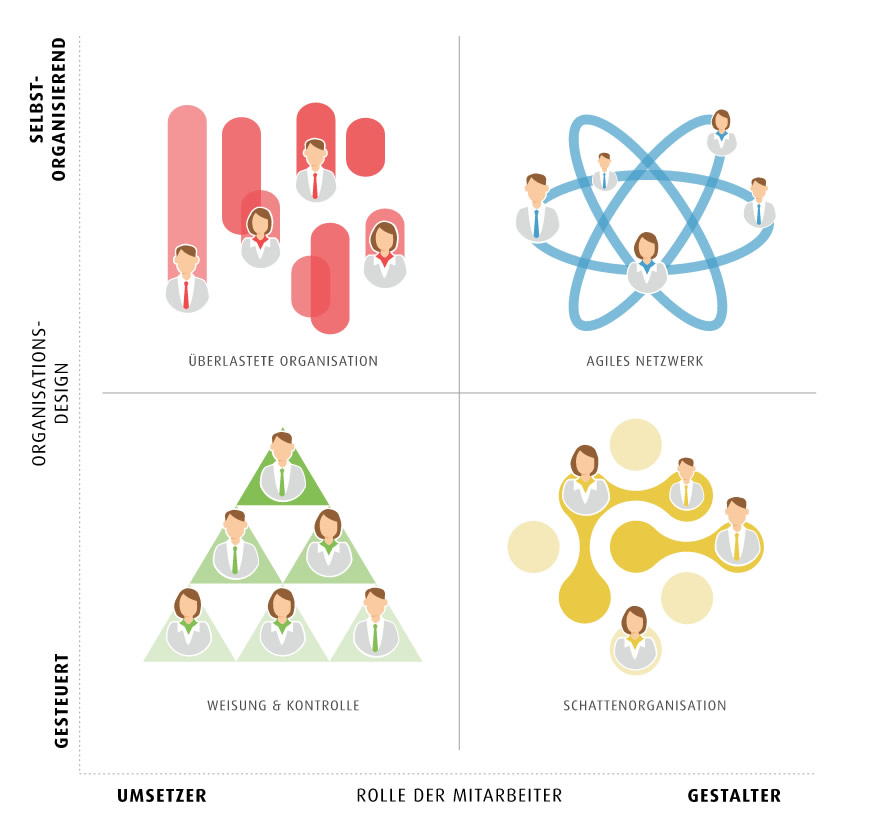
If organizational design and the self-understanding of the employees fit together, functioning systems are created. M. Stoffel , H.Arnold | Haufe
In an executive coaching, an experienced manager asked me what she could do in order not to discourage her employees in the transition phase from a rigid organizational form into a more mobile one. She herself notes that she takes her step by step, makes decisions, and then changes some of them. How can it be made clearer and clear from the outset?
It does not work. Insecurity is part of the transition, irritations give hints about the in-coming of movement. Moving around in small steps, making decisions to be able to act, changing decisions to remain viable. Produce voltage, withstand voltage. Is not always so simple.
We will be more effective when we deliberately deal with the dynamics of this kind, recognize our own patterns in these fields of tension, and develop ourselves together, in exchange with others. Because the changed organizational design is the one part of the story, the transformation in people the other.
Elisabeth Sechser, creative design & strategy sichtart

How strongly self-organized is corporate design? What is the design space of the people? Do you know the Haufe Quadrant? „The Haufe Quadrant forms the interplay between organizational design and the role of the employees and characterizes the organizational structure reality in companies. Within the quadrant, four different forms of organization are depicted: direction and control, shadow organization, overshadowed organization, and agile networks. In every company there are all forms. Some areas work well by direction and control, some teams work successfully as agile networks, and there are also employees who are or are overburdened in shadow organizations. Companies need to understand themselves as an ellipse in this quadrant, which encompasses the most diverse situations in all four areas.“
Source: Joachim Rotzinger, Haufe-Lexware GmbH & Co. KG, vision.haufe.de/blog/haufe-quadrant-unternehmensfuehrung-geht-nicht-nur-vom-management-aus/ von M. Stoffel und H.Arnold
It is also important to ensure that the phases of the transitions are well organized, that shadow organizations and overstretched teams are kept as low as possible, to make these phases bearable. These are questions about organizational design as well as questions to the people involved. How do managers help, how are dialogues made and made, who goes with, who moves constructively and learning in the required direction, who remains standing, turns around or goes out.
When is agile?

Welche Merkmale geben Auskunft über viel oder wenig Agilität im Team? Und ist viel Agilität immer gut? Oder anders gesagt – ist Weisung, Kontrolle, Hierarchie immer schlecht? Klingt wie eine Fangfrage, ist es aber nicht. Es geht darum herauszufinden, wohin sich aktuell das Unternehmen, der Bereich, das Team bewegt, wie viel Agilität erforderlich ist, um den Sinn der Organisation zu erfüllen, um sich mit und für Kundinnen und Kunden nutzerorientiert weiterzuentwickeln.
Agile Prinzipien von A bis V
Wir testen gerade Agilität-Checks und finden Tests mit bis zu 40 Merkmalen: Adaption, akzeptierte Verantwortung, Arbeit sichtbar machen, bevollmächtigtes Team, Business Value, das Ganze betrachten, Flow, Lernen verstärken, iterative Vorgehensweise, Mitmenschlichkeit, Ökonomie, aktive Einbeziehung, Qualität, reflektieren, regelmäßige Auslieferung, reversible Änderungen während der Entwicklung, sprechen statt ablegen, schnelles Scheitern, schnellstmöglich liefern, gegenseitiger Nutzen, selbstorganisiertes Team, spätestmögliche Entscheidung, Transparenz schaffen, unterstützende Kultur, Verschwendung eliminieren, Vielfalt usw. Quelle: Auszug aus NowConcept® Perfect Training Results Worldwide | Agile Prinzipien
Und auch hier ist der Wesenskern des Tests nicht das Ergebnis, sondern die reflexive Auseinandersetzung mit den tieferen Bedeutungen der einzelnen Begriffe, das Übereinanderlegen der einzelnen Einschätzungen und der Austausch dazu im Team. Das schafft Verständnis und bringt Erkenntnisse, die Auskunft geben was ein sinnvoller nächster Schritt sein könnte.
elisabeth sechser, creative design & strategy, Senior Executive Coach, Beraterin, Symbolon-Expertin

